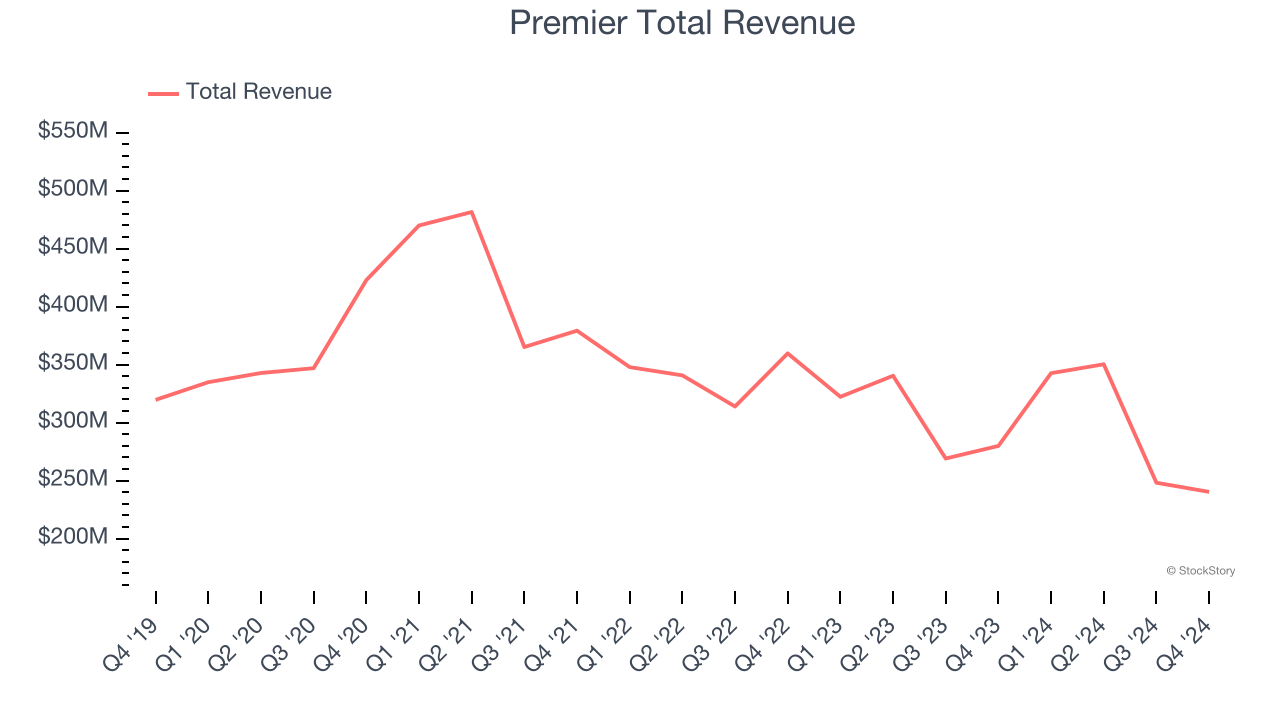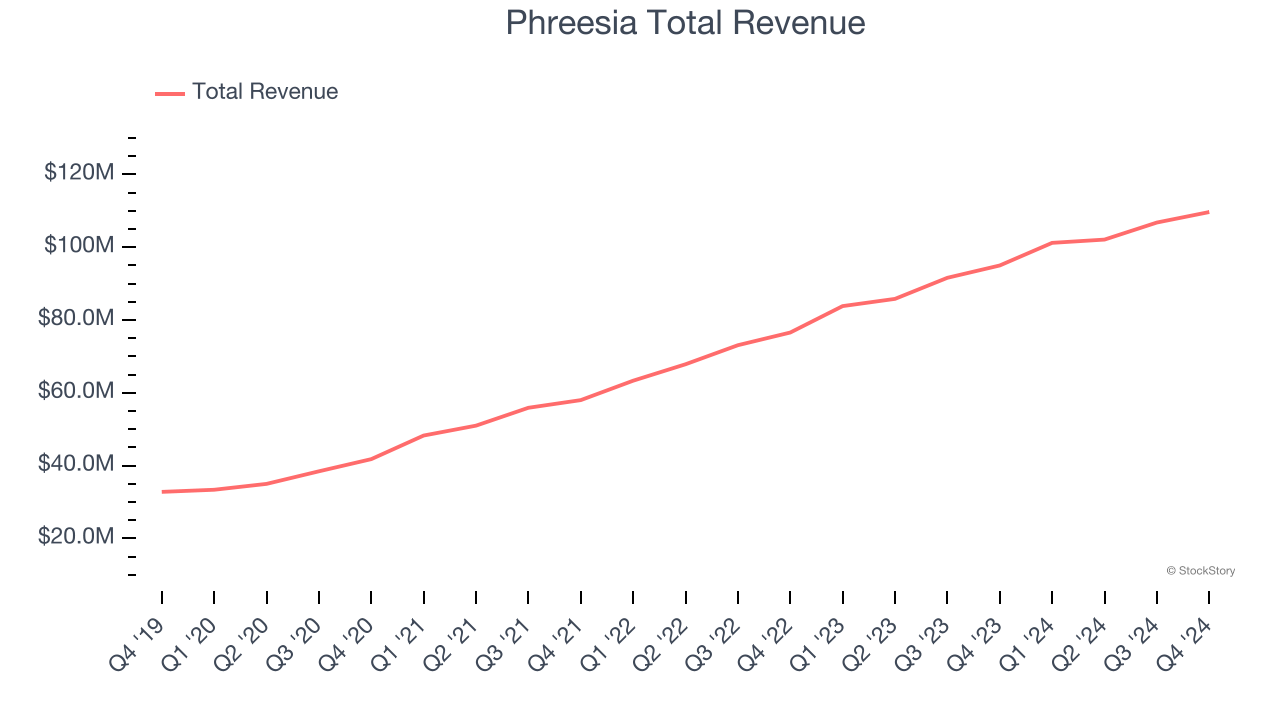
Looking back on healthcare technology for providers stocks’ Q4 earnings, we examine this quarter’s best and worst performers, including Premier (NASDAQ:PINC) and its peers.
The healthcare technology industry focuses on delivering software, data analytics, and workflow solutions to hospitals, clinics, and other care facilities. These companies enable providers to streamline operations, optimize patient outcomes, and transition to value-based care models. They boast subscription-based revenues or long-term contracts, providing financial stability and growth potential. However, they face challenges such as lengthy sales cycles, significant upfront investment in technology development, and reliance on providers’ adoption of new tools, which can be hindered by budget constraints or resistance to change. Over the next few years, the sector is poised for growth as providers increasingly prioritize digital transformation and efficiency in response to rising healthcare costs and patient demand for seamless care. Tailwinds include the growing adoption of AI-driven tools for patient engagement and operational improvements, government incentives for digitization, and the expansion of telehealth and remote patient monitoring. However, headwinds such as tightening hospital budgets, cybersecurity threats, and the fragmented nature of healthcare systems could slow adoption.
The 6 healthcare technology for providers stocks we track reported a slower Q4. As a group, revenues beat analysts’ consensus estimates by 3.1% while next quarter’s revenue guidance was 0.6% below.
Amidst this news, share prices of the companies have had a rough stretch. On average, they are down 10.5% since the latest earnings results.
Premier (NASDAQ:PINC)
Operating one of the largest healthcare group purchasing organizations in the United States with over 4,350 hospital members, Premier (NASDAQ:PINC) is a technology-driven healthcare improvement company that helps hospitals, health systems, and other providers reduce costs and improve clinical outcomes.
Premier reported revenues of $240.3 million, down 14.2% year on year. This print was in line with analysts’ expectations, but overall, it was a slower quarter for the company with a significant miss of analysts’ EPS estimates and full-year revenue guidance missing analysts’ expectations.
"Our overall revenue and profitability for the first half of fiscal 2025 were in line with our expectations resulting from better than expected results in our Supply Chain Services segment," said Michael J. Alkire, Premier's President and CEO.

Premier delivered the slowest revenue growth of the whole group. Unsurprisingly, the stock is down 14.2% since reporting and currently trades at $19.23.
Read our full report on Premier here, it’s free.
Best Q4: Phreesia (NYSE:PHR)
Founded in 2005 to streamline the traditionally paper-heavy patient check-in process, Phreesia (NYSE:PHR) provides software solutions that automate patient intake, registration, and payment processes for healthcare organizations while improving patient engagement in their care.
Phreesia reported revenues of $109.7 million, up 15.4% year on year, outperforming analysts’ expectations by 0.7%. The business had a strong quarter with a solid beat of analysts’ EPS estimates and full-year EBITDA guidance topping analysts’ expectations.

The market seems happy with the results as the stock is up 5.5% since reporting. It currently trades at $25.19.
Is now the time to buy Phreesia? Access our full analysis of the earnings results here, it’s free.
Weakest Q4: Evolent Health (NYSE:EVH)
Founded in 2011 to transform how healthcare is delivered to patients with complex needs, Evolent Health (NYSE:EVH) provides specialty care management services and technology solutions that help health plans and providers deliver better care for patients with complex conditions.
Evolent Health reported revenues of $646.5 million, up 16.3% year on year, falling short of analysts’ expectations by 0.7%. It was a softer quarter as it posted a significant miss of analysts’ EPS estimates and EBITDA guidance for next quarter missing analysts’ expectations.
Evolent Health delivered the weakest performance against analyst estimates and weakest full-year guidance update in the group. As expected, the stock is down 15.3% since the results and currently trades at $9.09.
Read our full analysis of Evolent Health’s results here.
Astrana Health (NASDAQ:ASTH)
Formerly known as Apollo Medical Holdings until early 2024, Astrana Health (NASDAQ:ASTH) operates a technology-powered healthcare platform that enables physicians to deliver coordinated care while successfully participating in value-based payment models.
Astrana Health reported revenues of $665.2 million, up 88.4% year on year. This number surpassed analysts’ expectations by 6.9%. Taking a step back, it was a mixed quarter as it also produced full-year revenue guidance beating analysts’ expectations but full-year EBITDA guidance missing analysts’ expectations.
Astrana Health scored the fastest revenue growth and highest full-year guidance raise among its peers. The stock is down 8.1% since reporting and currently trades at $31.87.
Read our full, actionable report on Astrana Health here, it’s free.
Privia Health (NASDAQ:PRVA)
Operating in 13 states and the District of Columbia with over 4,300 providers serving more than 4.8 million patients, Privia Health (NASDAQ:PRVA) is a technology-driven company that helps physicians optimize their practices, improve patient experiences, and transition to value-based care models.
Privia Health reported revenues of $460.9 million, up 4.6% year on year. This result topped analysts’ expectations by 9.4%. Zooming out, it was a satisfactory quarter as it also recorded an impressive beat of analysts’ sales volume estimates.
Privia Health delivered the biggest analyst estimates beat among its peers. The stock is down 1.5% since reporting and currently trades at $23.69.
Read our full, actionable report on Privia Health here, it’s free.
Market Update
As a result of the Fed’s rate hikes in 2022 and 2023, inflation has come down from frothy levels post-pandemic. The general rise in the price of goods and services is trending towards the Fed’s 2% goal as of late, which is good news. The higher rates that fought inflation also didn't slow economic activity enough to catalyze a recession. So far, soft landing. This, combined with recent rate cuts (half a percent in September 2024 and a quarter percent in November 2024) have led to strong stock market performance in 2024. The icing on the cake for 2024 returns was Donald Trump’s victory in the U.S. Presidential Election in early November, sending major indices to all-time highs in the week following the election. Still, debates around the health of the economy and the impact of potential tariffs and corporate tax cuts remain, leaving much uncertainty around 2025.
Want to invest in winners with rock-solid fundamentals? Check out our Top 6 Stocks and add them to your watchlist. These companies are poised for growth regardless of the political or macroeconomic climate.
Join Paid Stock Investor Research
Help us make StockStory more helpful to investors like yourself. Join our paid user research session and receive a $50 Amazon gift card for your opinions. Sign up here.
